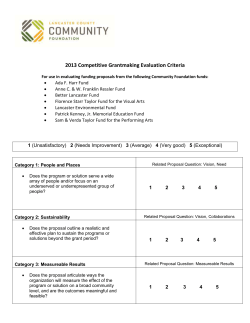
EXAM SAMPLE PROBLEMS
BEA, LEVERAGES EXAM SAMPLE PROBLEMS 1. At a production level of 6,500 units, a project has total costs of $95,000. The variable cost per unit is $10.80. What is the amount of the total fixed costs if the production level is increased to 7,000 units without increasing the total fixed assets? 2. What is operating leverage and why is it important in the analysis of capital expenditure projects? 3. The fixed costs of a project are $6,000. The depreciation expense is $4,500 and the operating cash flow is $18,000. What is the degree of operating leverage for this project? 4. The department manager has noted that every time the sales quantity increases by 6 percent for a particular project, the operating cash flow for the project increases by 9 percent. What is the degree of operating leverage for this project if the contribution margin is $2? 5. A coworker is in charge of a project that has a degree of operating leverage of 2.0. What will happen to the operating cash flows if your coworker decreases the number of units sold by 10 percent? 6. A company is considering a project with a cash break-even point of 14,500 units. The selling price is $14 a unit and the variable cost per unit is $8. What is the projected amount of fixed costs? 7. Your company is reviewing a project with labor cost of $11.60 per unit, raw materials cost of $24.58 a unit, and fixed costs of $12,000 a month. Sales are projected at 10,000 units over the four-month life of the project. What are the total variable costs of the project? 8. Heister Corporation produces class rings to sell to college and high school students. These rings sell for $75 each, and cost $35 each to produce. Heister has fixed costs of $50,000. a) Calculate Heister's break-even point. b) How much profit (loss) will Heister have if it sells 1,000 rings? 8,000 rings? c) Heister's president, J. R. D'Angelo, expects an annual profit of $100,000. How many rings must be sold to attain this profit? 9. From the following income statement, calculate: a) Degree of financial leverage. b) Degree of operating leverage. c) Degree of combined leverage. BEA, LEVERAGES EXAM SAMPLE PROBLEMS 10. Yaseen’s Co. Inc. has following income statement: Calculate the following parameters for the company: a. The firm's break-even point; b. The Degree of Operating Leverage (DOL) c. The Degree of Combined Leverage (D.C.L.) 11. Firm A produces semiconductors using highly technical machinery; Firm B is a retail clothing store. Consider which firm employs a higher degree of operating leverage and then answer the following question: "Which of the following comparative statements about firms A and B is true?" A. A has a lower break-even point than B, but A's profit grows faster after the breakeven. B. A has a higher break-even point than B, but A's profit grows slower after the breakeven. C. B has a lower break-even point than A, but A's profit grows faster after break-even. D. B has a lower break-even point than A, and profit grows at the same rate for both companies after the breakeven point.
© Copyright 2025





















